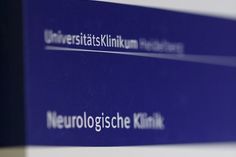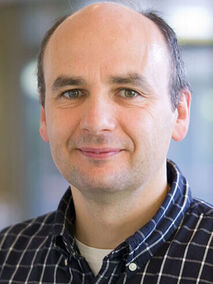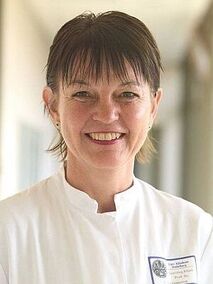Projects
Quality inspections for musical instruments
Modelling of the basilar membrane
Musical processing and the auditory cortex
Structural, functional and perceptual differences in the auditory cortex of musicians and non-musicians
The musical pitch of harmonically complex tones differs by up to three or four octaves when the same tone is played to different listeners. Some listeners are more likely to recognise the fundamental tone of a sound (the periodic pitch), others are more likely to recognise individual overtones. In order to quantify these subjective differences already described by Hermann von Helmholtz, we designed a detailed pitch test with 162 different pairs of harmonically complex tones (Schneider et al., 2005). The test was carried out with 306 professional musicians, 66 amateur musicians and 48 non-musicians and showed a broad distribution that allowed the listeners to be divided into two groups, the "fundamental listeners" and the "overtone listeners".
In 87 test subjects, the brain was additionally imaged anatomically using magnetic resonance imaging (MRI) and the brain waves were measured using magnetoencephalography (MEG) when listening to sounds. Fundamental tone listeners showed a significantly larger volume of grey matter in the lateral area of the left Heschl's gyrus and also greater P50 activation than in the right Heschl's gyrus. In overtone listeners, on the other hand, the right Heschl's gyrus was more pronounced.
While the left-right asymmetry associated with pitch perception occurred in the same way in both professional and non-musicians, the absolute size of the neuronal substance was strongly dependent on the musical disposition. Professional musicians showed a Heschl's gyrus that was twice as large as that of non-musicians. The P50 activation generated in the lateral area of the Heschl gyrus was even five times more pronounced. The volume of grey matter correlated only with musical aptitude, measured using the AMMA test by Edwin E. Gordon's AMMA test, whereas P50 activation correlated exclusively with long-term musical training.
Furthermore, an influence on the preference for certain musical instruments was found. As the left auditory cortex is responsible for rapid temporal processing, fundamental tone listeners prefer musical instruments that produce short, sharp or impulsive tones (drums, guitar, piano or high solo instruments such as trumpet or flute). The right Heschl gyrus, on the other hand, prefers to process spectral frequencies or tone colours. Consequently, overtone listeners tend to choose instruments that produce long sustained tones with characteristic timbres or formants in the spectrum (string, brass or woodwind instruments in lower registers, organ or voice). Musicians who play the same main instrument but hear it differently also often differ in their playing style: Fundamental listeners prefer to play with virtuosity or rhythmic emphasis, overtone listeners are more interested in tone colours and longer sustained melodic arcs.
Both the size and the relative weighting of the Heschl Gyri have an influence on pitch perception, sound perception, preference of musical instruments and musical composition.
Participants
Co-operation partner
Hans-Joachim Specht
Temporal and spectral pitch
Huygens noise or regular interval noise (RIN) is generated by delaying the superimposition of white noise on itself (delay-and-add). The resulting tonal impression depends on the time delay and becomes stronger and stronger as the number of iterations increases. If the delayed signal is subtracted (delay-and-subtract), the perceived pitch changes in comparison to the delay-and-add process. However, psychoacoustic tests show that a delay time of less than approx. 5 ms results in a pitch shift of one octave. As the delay increases, the pitch shift decreases to one second.
Magnetoencephalography is used in an attempt to correlate the psychoacoustic results with activation in the Heschl gyrus.
Participants
Co-operation partner
Hans-Joachim Specht
Chirps - Peripheral synchronisation
This project investigates the effect of an optimal chirp, i.e. a broadband stimulus that compensates for the delay along the basilar membrane. The chirp used in our investigations was developed by Torsten Dau and Oliver Wegner on the basis of the linear cochlear model of DeBoer (1980).
It is assumed that the increasing frequency of the stimulus triggers simultaneous excitation along the basilar membrane, resulting in a greatly increased singal-to-noise ratio compared to a click stimulus. This property is to be utilised in future clinical studies when investigating primary cortical responses.
Empirical evidence for these properties, which have already been demonstrated at the wave V level of brainstem potentials, was found in an MEG study.
This project is being carried out in collaboration with Stefan Uppenkamp, Medical Physics at the University of Oldenburg, Roy D. Patterson, CNBH, University of Cambridge, and Torsten Dau, Centre for Applied Hearing Research, Technical University of Denmark.
Funded by the German Research Foundation (Ru 652/1-3).
Participants
Co-operation partner
Temporal Asymmetry in the Auditory Cortex
Psychophysical studies show that human listeners are highly sensitive to temporal asymmetry. When an amplitude modulator that is asymmetric in time is applied to a sinusoidal tone, the direction of the asymmetry affects a timber of the sound. A sinusoid modulated by a decaying exponential results in a damped sinusoid which has a dominant drumming percept. However, if the modulator is reversed in time to produce a ramped sinusoid, the percept is more tonal. The present magnetoencephalography (MEG) study was carried out to investigate the temporal processing by analyzing middle latency and sustained auditory evoked fields. The resulting morphology of the responses depended strongly on the temporal features of the envelope of the sounds and less of the specific spectral content of the carrier. The measurments and analysis of neuromagnetic responses offer a sensitive technique to study the relationship of physiological and psychophysical responses to temporal asymmetric stimuli that play a major role in communication sounds.
Funded by the Deutsche Forschungsgemeinschaft (Ru 652/1-3).
Participants
Co-operation partner
Anita Kult
Sound List Processor
Slp is a tool for auditory stimulation. It is able to read a list describing certain sound events. We use it to present acoustic stimuli to subjects during MEG and EEG recording sessions. The sounds can be read from files using common file formats. Additionally, one can define online generated sounds in a C++ class and link it to slp. This is useful especially when using randomly generated sounds, which can not be pre-generated. Slp also provides a fast convolution algorithm to filter each sound one specifies in realtime using a user-designed FIR filter.
Funded by the Deutsche Forschungsgemeinschaft (Ru 652/1-3).
Participants
Visual attention in sport-specific decision-making processes
Referees have to perform high levels of attention over a relatively long period of time. The aim of this project is to investigate differences in selective visual attention between experienced referees and sports students familiar with the rules using visual evoked potentials (EEG) and fields (MEG). The focus is both on the early activations, which are usually independent of attention and reflect bottom-up processes, and on the late components, which are strongly influenced by cognitive processes.
Participants
Co-operation partner
Daniel Memmert








